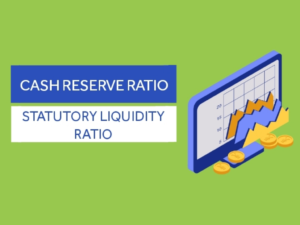Difference between CRR and SLR
What is CRR?
The Cash Reserve Ratio (CRR) is the percentage of a bank’s total deposit balances that must be maintained as cash reserves with the central bank. It is a regulatory measure imposed by central banks to control inflation and stabilize the economy.
Examples of CRR
For example, if the central bank sets the CRR at 4%, a bank with total deposits of $1,000,000 must maintain $40,000 as cash reserves with the central bank.
What is SLR?
The Statutory Liquidity Ratio (SLR) is the percentage of a bank’s total deposit balances that must be invested in specified liquid assets such as government securities. It is also a regulatory measure imposed by central banks to ensure the stability of the banking system and control credit expansion.
Examples of SLR
For example, if the central bank sets the SLR at 20%, a bank with total deposits of $1,000,000 must invest $200,000 in specified liquid assets like government securities.
Differences between CRR and SLR
| Difference Area | CRR | SLR |
|---|---|---|
| Definition | Percentage of total deposit balances maintained as cash reserves | Percentage of total deposit balances invested in specified liquid assets |
| Imposed by | Central bank | Central bank |
| Purpose | To control inflation and stabilize the economy | To ensure the stability of the banking system and control credit expansion |
| Requirement | Mandatory | Mandatory |
| Applicable to | Commercial banks | Commercial banks |
| Reserves | Cash reserves with the central bank | Investment in specified liquid assets |
| Control Method | Direct control over cash reserves | Indirect control through investment in liquid assets |
| Impact on Liquidity | Reduces liquidity in the banking system | Increases liquidity in the banking system |
| Flexibility | Fixed percentage set by the central bank | Variable percentage set by the central bank |
| Influence on Interest Rates | May indirectly influence interest rates | May indirectly influence interest rates |
Conclusion
In summary, CRR and SLR are both regulatory measures imposed by central banks. CRR requires banks to maintain a certain percentage of their total deposit balances as cash reserves, while SLR requires banks to invest a certain percentage of their total deposit balances in specified liquid assets. The purposes and methods of control differ slightly, but both aim to maintain stability in the banking system.
People Also Ask
1. What is the purpose of CRR and SLR?
The purpose of both CRR and SLR is to regulate and control various aspects of the banking system, such as inflation, credit expansion, and overall stability.
2. Are CRR and SLR mandatory for all banks?
Yes, CRR and SLR are mandatory requirements applicable to all commercial banks.
3. What happens if a bank fails to meet the CRR or SLR requirements?
If a bank fails to meet the CRR or SLR requirements, it may face penalties or fines imposed by the central bank. Additionally, it may impact the bank’s ability to lend or expand its operations.
4. How often can the central bank change the CRR or SLR?
The central bank has the authority to change the CRR or SLR as and when necessary based on economic conditions. However, these changes are not frequent and are typically implemented after careful consideration.
5. Do CRR and SLR have any direct impact on the interest rates offered by banks?
CRR and SLR may indirectly influence interest rates by affecting the liquidity in the banking system. Higher CRR or lower SLR may reduce liquidity, leading to increased interest rates, and vice versa.



